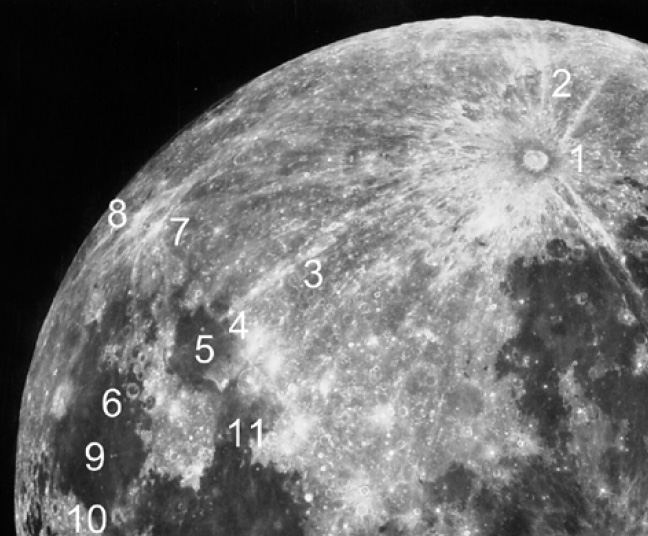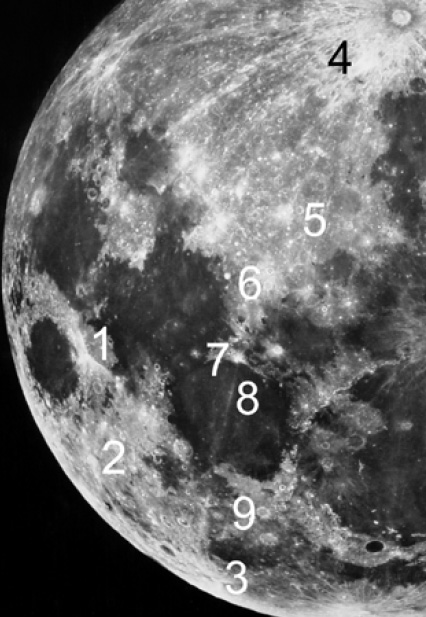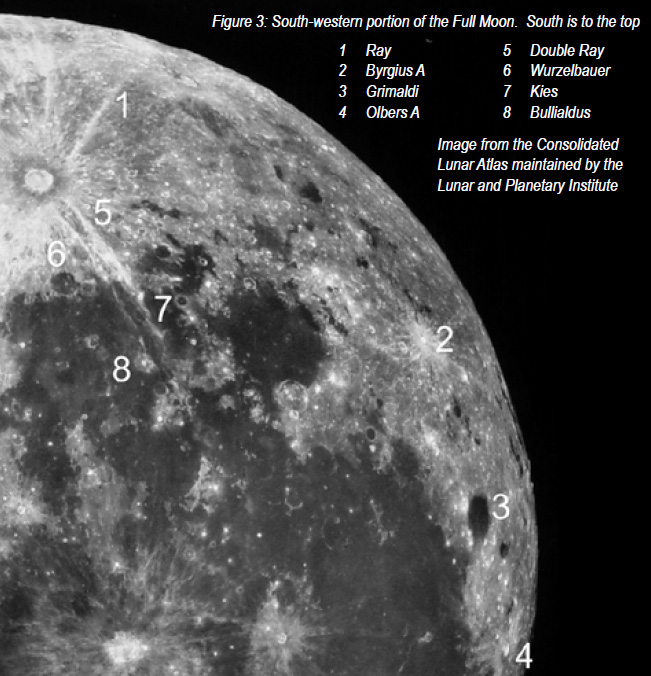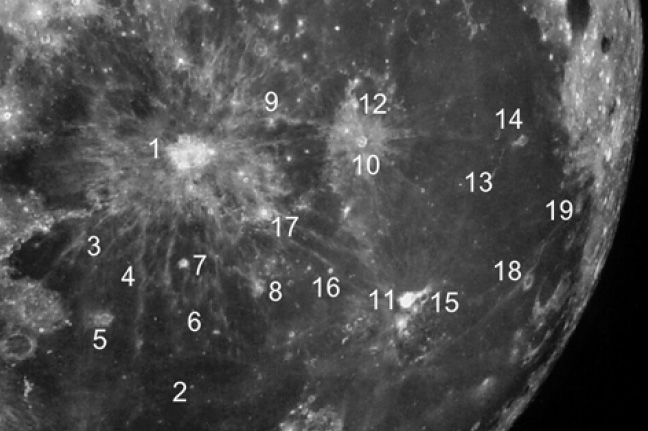Following the Terminator Part 8
By Joseph Cohen
First published Crux Aug-Sep 2008
Day 14
The Ray Systems
Tonight is the theoretical time of the Full Moon when the morning terminator passes around the west end of the globe to illuminate the unseen portion of the Moon. However the position of the terminator relative to lunar features depends on a number of factors including the time of onset of lunation, its rotation, libration and the time of observing so there may be a variation of two to twelve hours at different lunations. The brightness of the Full Moon tends to obscure details east of the terminator and some craters are washed out, but filters or reducing the aperture will help. The period about the Full Moon is the appropriate time to observe the details of most ray systems as generally most rays, coronas, bright craters, craterlets and bright spots increase their brightness with overhead lighting. The location of the many prominent light and dark spots should be noted and charted as they can act as a guide to other structures. Only the more obvious and useful features will be considered here.
East Hemisphere
In the Southern Hemisphere, TYCHO (Fig.1, 1) dominates the scene and spreads its rays over a wide area. Its central mountains are lost in the glare of the brightness of its floor and a dark ring that may not have been seen earlier separates the crater from its corona whence a number of useful rays emerge. Starting from Tycho’s southern edge, a thin ray on the extended line of the north-south axis of the “Southern Cross” crosses the centre of CLAVIUS (Fig.1, 2) to pass through the “gutter” (see Day 11- 14) to point to CABEUS at the limb.

Figure 1:
South-eastern portion of the Full Moon. South is to the top
1 Tycho 2 Clavius 3 Ray 4 Fracastorius E 5 Rosse 6 Goclenius 7 Stevinus 8 Furnerius 9 Messier 10 Taruntius 11 Torricelli
Image from the Consolidated Lunar Atlas maintained by the Lunar and Planetary Institute
To its east the long irregular MALAPERT may be found on a south line from MORETUS through SHORT with the LEIBNITZ MOUNTAINS at the limb east of the South Pole, if libration is favourable. A thick ray from the east side of Tycho’s corona (Fig.1, 3) crosses the ALTAI scarp passing over several bright craterlets to meet the small bright craterlet FRACASTORIUS E (Fig.1, 4) that is the smallest and northernmost member of the three at its parent’s west side. The ray enters M. NECTARIS crossing ROSSE (Fig.1, 5) and the rest of the sea to point to GOCLENIUS, (Fig.1, 6; the eye of the Lady of the Moon) at the east coast of the Lesser Peninsula. South of this ray and arising from the same area, a second ray passes east to join the halo of the STEVINUS-SNELLIUS group (Fig.1, 7), whilst a third thicker ray further south joins the halo of FURNERIUS (Fig.1, 8.) The three halos form a bright splash that hides their craters. From Stevinus a thin ray extends north to enter M. FOECUNDITATUS, passing east of Goclenius to meet MESSIER (Fig.1, 9) and its close west companion MESSIER A (nee W.H. PICKERING) and continuing to TARUNTIUS (Fig.1, 10) in the northern part of the sea. The Messier twins send their own two parallel rays from the west crater to the coast of the Lesser Peninsula where a projected line crosses several tiny inland craterlets that point to the pear shaped TORRICELLI (Fig.1, 11) near the east coast of the strait between M. Nectaris and M. TRANQUILLITATIS. West of M. CRISIUM, at the edge of PALUS SOMNII, the open fan of the dark floored PROCLUS (Fig.2, 1) is seen, but its brightness and development should be followed from its earliest days (see Day 5) when its two arms develop into a fan. Note the sharp west edge of the fan and that it does not spread to the lower Palus.
A third of the distance between M. Crisium and the North Pole, GEMINUS (Fig.2, 2) is credited with a ray system due to the impact of two craterlets nearby. Closer to the pole and northwest of the large DE LA RUE, THALES (Fig.2, 3) has a ray system like a half open fan whose east and west edges are brightly lit and stand out from its background. A south bound ray can be seen crossing M. FRIGORIS.

Figure 2 :
Eastern portion of the Full Moon. South is to the top
1 Proclus 2 Geminus 3 Thales 4 Cassini’s Bright Spot 5 Hind 6 Agrippa 7 Menelaus 8 Bessel 9 Burg
Image from the Consolidated Lunar Atlas maintained by the Lunar and Planetary Institute
The “Round the Moon Ray” is an illusion caused by a number of separate bright spots, craters, craterlets and rays giving the impression of a continuous northeast ray. However it is a useful guide to a number of structures. The large DESLANDRES has at its east floor CASSINI’S BRIGHT SPOT (Fig.2,4), generally regarded as the start of the ray. The ray then crosses several bright craterlets including the small bright HIND (Fig.2, 5), the second member of the curved HALLEY group east of the ALBATGENIUS-HIPPARCHUS ‘junction’. The line then enters the northern hemisphere to cross the prominent craters GODIN and AGRIPPA (Fig.2, 6) and join the bright corona of MENELAUS (Fig.2, 7) that is at the shore of the HAEMUS MOUNTAINS. A north ray from that crater crosses BESSEL (Fig.2, 8) in M. SERENITATIS and continues on to enter LACUS SOMNIORUM east of the southeast tip of the LONG ISLAND. It then enters LACUS MORTIS east of BURG (Fig.2, 9) in the centre of the Lacus to cross M. Frigoris ending at Thales northwest of the large Del La Rue.
West Hemisphere
From the southwest of the corona outside Tycho’s dark ring, a south-southwest ray (Fig.3, 1) crosses the southeast side of LONGOMONTANUS then the west end of SCHEINER to reach KIRCHER, the southern member of a triad of similar oval craters.

Figure 3
The ray then crosses the south end of the large BAILY to point to the DOERFEL MOUNTAINS at the limb. West of Tycho there is a wide open angle of over 90 degrees devoid of any prominent rays. Further to the north along the west limb, slightly southeast of the LAMARCK-DARWIN group, BYRGIUS A (Fig.3, 2) sitting on its parent’s east wall has a wide corona and ray system. Further north and past the GRIMALDI (Fig.3, 3) chain, the craterlet OLBERS A (Fig.3, 4) northwest of its parent also has a corona that masks OLBERS lying west of CAVALERIUS. It also receives a ray (ridge) from ARISTARCHUS (see later.) Returning to Tycho, emerging from the northwest side of its corona the “DOUBLE RAY” (Fig.3, 5) appears consisting of a thin east branch and a thicker west branch whose parallel rays travel northwest and are separated by a dark strip. The east branch passes over a group of several small craters east of the distinctive HEINSIUS, including the larger north HEINSIUS N that has a craterlet in its northwest floor, to cross the west side of the dark floored WURZELBAUER (Fig.3, 6) and enter M. NUBIUM where, passing east of KIES (Fig.3, 7), a ghost crater, it meets BULLIALDUS B the second small crater of the spiral south of its parent BULLIALDUS (Fig.3, 8.) The ray touches the large crater’s southwest side and shortly ceases its journey. The thicker western branch touches the east wall of Heinsius that is recognized by three deep small craters at its southwest wall and crosses the small WURZELBAUER D with three tiny craterlets on its walls. It lies south and slightly west and close to its parent. The branch then touches the east wall of the small CICHUS that has a craterlet on its west wall and crosses the west floor of Kies in M. Nubium, followed by the small KONIG, the third member of the spiral from Bullialdus, where it broadens and fades as it crosses the north part of the HIPPALUS PENINSULA.
COPERNICUS (Fig.4, 1) has many fine rays spreading 360 degrees with thicker rays at its north and west sides that communicate with other structures. The craterlets and ridges from STADIUS leading into M. IMBRIUM (Fig.4, 2) are not part of Copernicus’ system and have been considered in Day 9-10 and will not be repeated. A thin ray from Copernicus’ east corona passes northeast and north of ERATOSTHENES to cross the shallow WALLACE (Fig.4, 3) in M. Imbrium. A prominent ray (Fig.4, 4) passes north between TIMOCHARIS (Fig.4, 5) and LAMBERT (Fig.4, 6) with a second ray curving past PYTHEAS (Fig.4, 7) to reach Lambert. Further west a broken ray reaches EULER (Fig.4, 8.) A curved west ray from Copernicus’s southwest side crosses the craterlet HORTENSIUS (Fig.4, 9) to reach KEPLER’S (Fig.4, 10) corona and another ray further north passes a small ridge and MILICHIUS to also reach Kepler.

Figure 4 :
Central-western portion of the Full Moon. South is to the top
1 Copernicus 2 M. Imbrium 3 Wallace 4 Ray 5 Timocharis 6 Lambert 7 Pytheas 8 Euler 9 Hortensius 10 Kepler 11 Aristarchus 12 Encke 13 Marius 14 Reiner 15 Herodotus 16 Brayley 17 Tobias Mayer 18 Seleucus 19 Cardanus
Image from the Consolidated Lunar Atlas maintained by the Lunar and Planetary Institute
Kepler west of Copernicus has a denser corona and well-defined rays joining itself to Copernicus and ARISTARCHUS (Fig.4, 11.) No obvious rays are present in the south but ENCKE (Fig.4, 12), a small crater, is in that part of its corona. The curved ray from Hortensius meets Kepler’s corona at its east side and slightly north a second ray from Milichius can be seen. Several rays from Kepler’s north side pass to Aristarchus whilst from its west side a thin ray passes northwest to MARIUS (Fig.4, 13) and further south a thicker west ray meets REINER (Fig.4, 14), a slightly smaller crater.
Aristarchus, the brightest crater on the visible side of the Moon, has connections to Copernicus, Kepler and indirectly with Olbers. Its bright corona hides the crater at Full Moon but this does not affect the dark floored HERODOTUS (Fig.4, 15) at its west side. The rays to Kepler have been mentioned and two almost parallel rays pass to Copernicus, the north one crossing the craterlet BRAYLEY (Fig.4, 16) and the south one TOBIAS MAYER (Fig.4, 17) at the end of the CARPATHIAN MOUNTAINS. A third curved ray south of the pair also reaches Copernicus. From the south end of Aristarchus’ corona, three slightly divergent rays pass to Kepler’s corona and another ray passes west of the crater. Many other fine rays fan out over the area south of Aristarchus. Two interesting rays pass west from the area around Aristarchus. A north ray commences at a small mountain ridge north of the crater passing southwest to meet the east side of SELEUCUS (Fig.4, 18) and continues to Olbers’ corona. A second ray starts north of Herodotus and also passes to Seleucus where further south it crosses over the north ray moving on a southwest path to reach CARDANUS (Fig.4, 19) north of Olbers. Low lighting will show that these rays are in fact low ridges.
Near the North Pole area the small ANAXAGORAS invading the west wall of GOLDSCHMIDT is the centre of a number of wide-reaching fine rays.